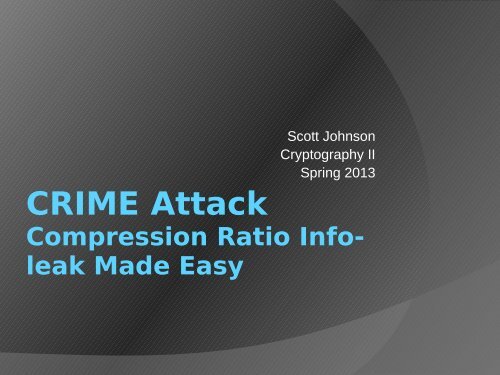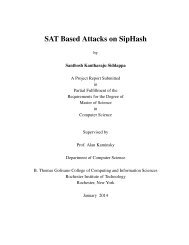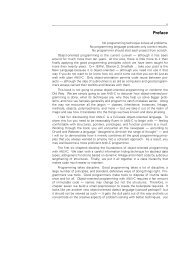CRIME Attack
CRIME Attack
CRIME Attack
You also want an ePaper? Increase the reach of your titles
YUMPU automatically turns print PDFs into web optimized ePapers that Google loves.
Scott Johnson<br />
Cryptography II<br />
Spring 2013<br />
<strong>CRIME</strong> <strong>Attack</strong><br />
Compression Ratio Infoleak<br />
Made Easy
What is <strong>CRIME</strong>?<br />
Exploit for SSL/TSL<br />
<br />
<br />
Takes Advantage of Compression in<br />
SSL/TSL<br />
Allows <strong>Attack</strong>er To Obtain Control
Who and When of <strong>CRIME</strong>?<br />
<br />
<br />
<br />
security researchers<br />
Juliano Rizzo<br />
Thai Duong<br />
Also created the BEAST exploit<br />
Browser Exploit Against SSL/TLS<br />
Introduced at the 2012 Ekoparty<br />
Security Conference
Background Information<br />
<br />
What is SSL/TSL<br />
Security Protocols to assist in transferring<br />
data securely via the Internet<br />
Built-in Compression Option<br />
Requires a Session Cookie Containing a<br />
Key to Validate Messages<br />
Used by Many Websites that Require<br />
Security
How Does <strong>CRIME</strong> Work?<br />
<br />
<br />
The attacker creates a special<br />
JavaScript<br />
Script will append data to attackee’s<br />
transmissions<br />
This data is very specific and created to<br />
obtain patterns<br />
The attacker introduces the JavaScript<br />
into the attackee’s system
How Does <strong>CRIME</strong> Work? (con’t)<br />
Once in the system JavaScript executes<br />
<br />
Finds active SSL/TSL Connections<br />
Appends Specific Patterns to Outgoing SSL<br />
Messages<br />
Repeats the Appending Process to Output<br />
Various Predefined Patterns<br />
Done Before Encryption/Compression<br />
<strong>Attack</strong>er Obtains Encrypted Message via<br />
Man-in-the-Middle method
How Does <strong>CRIME</strong> Work? (con’t)<br />
<br />
<br />
<br />
<br />
<strong>Attack</strong>er Compares Messages to<br />
Achieve Patterns Created By JavaScript<br />
<strong>Attack</strong>er Acquires Compression and<br />
Encryption Methods via Patterns<br />
<strong>Attack</strong>er Obtains Session Cookie<br />
Information from Header via<br />
Compression and Encryption Method<br />
<strong>Attack</strong>er Uses Cookie Information to<br />
Hijack Session
How Are The Patterns Obtained?<br />
<br />
<br />
<strong>Attack</strong>er Uses SSL’s Compression to<br />
Create Patterns<br />
<strong>Attack</strong>er Introduces a Three Character<br />
Pattern to Same <strong>Attack</strong>ee Message<br />
Multiple Times<br />
Three characters must all be the same
The Pattern<br />
Example of Pattern<br />
<strong>Attack</strong>ee’s data: [unknown]<br />
<strong>Attack</strong>er Appends Various Three Characters<br />
AAA[unknown]<br />
BBB[unknown]<br />
Etc.<br />
SSL Compresses and Encrypts<br />
<strong>Attack</strong>er Obtains Compressed and Encrypted<br />
Message
The Pattern (con’t)<br />
<strong>Attack</strong>er Compares Message Lengths<br />
<br />
<br />
AAA[unknown] = 1df4h6a<br />
BBB[unknown] = 23fdhd234<br />
Etc.<br />
AAA[unknown] has a smaller message length<br />
Due to compression the first character in the<br />
unknown data must be an A.<br />
<strong>Attack</strong>er Repeats To Obtain A<br />
Compression/Encryption Pattern
Compression/Encryption Pattern<br />
<br />
<br />
With Pattern In Hand<br />
<strong>Attack</strong>er obtains session header<br />
Uses Compression/Encryption Pattern to<br />
decode header<br />
From header the attacker obtains all cookie<br />
information<br />
With Cookie Information <strong>Attack</strong>er Can<br />
Act As The <strong>Attack</strong>ed System and Send<br />
Messages To Host
How To Prevent <strong>CRIME</strong>?<br />
Simple Solutions<br />
<br />
Turn off compression at either end of the<br />
connection<br />
Use another form of secure connection<br />
<strong>CRIME</strong> is still relatively new<br />
More in-depth solution are being researched<br />
Exact details of attack a not published<br />
<strong>CRIME</strong> creators are working with NIST to<br />
create a solution
Browsers and <strong>CRIME</strong><br />
<br />
<br />
<br />
<br />
Microsoft Internet Explorer is not<br />
vulnerable to <strong>CRIME</strong><br />
Crome added patch to latest version to<br />
mitigate <strong>CRIME</strong> attack<br />
FireFiox also added patch to latest<br />
version to mitigate <strong>CRIME</strong> attack<br />
Many Websites have added protection<br />
on their end to thwart <strong>CRIME</strong> attacks
Conclusion<br />
<strong>CRIME</strong> is a very specific attack<br />
<br />
<br />
Can be easily avoided<br />
This avoidance comes with transmission speed<br />
decrease<br />
Users must determine if compression or<br />
security is top priority<br />
Compression increases speed but allows for<br />
<strong>CRIME</strong><br />
Security Defeats <strong>CRIME</strong> but disables<br />
Compression.
Conclusion (con’t)<br />
<br />
<strong>CRIME</strong> was easily defeated, but….<br />
Will its knick in the armor of SSL/TSL put<br />
doubts in the minds of the computer security<br />
world?
















